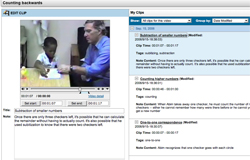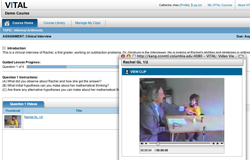The VITAL Environment
VITAL provides students with activities and tools that encourage analysis and critical thought, and foster independent study as well as collaboration. Watch the video below for a demonstration of VITAL's primary features.
In summary, the elements of VITAL are:
* Video viewer that allows students to excerpt, annotate, and store specific segments of video (figure 1 below)
* Workspace in which students can embed their video clips as citations in "multimedia essays" (figure 2)
* Guided lessons that present students with simulated interactions with children (figure 3, not in demo video)
* Course library of videos selected by the instructor or contributed by students (figure 4)
Analysis & Reflection
 |
| Figure 1 |
The student views videos in a viewer window that contains tools for clipping excerpts of video and writing notes. The student gives each clip a title and can also compose notes and attach keywords about the clip. The ability to view videos repeatedly lets students build understanding at their own pace and practice their observation skills in a controlled context.
Integrative Essay
 |
| Figure 2 |
Saved video clips are stored in a Workspace, where students can view their selections and organize them for writing a multimedia essay. The Workspace provides an essay writing space and tools for embedding video citations directly within the students' text. Students can use the videos as evidence to support arguments, and instructors can assess the students' interpretation skills and how effectively they use the materials in their essays.
Guided Lessons
 |
| Figure 3 |
Guided lesson are linear, question-by-question exercises. These lessons mimic real-time events in which students must make an interpretation or decision based on limited information. After answering a question, students might read an expert's commentary that encourages them to reflect and refine their thinking. These tools can also aid students in practicing research skills such as naturalistic observation and clinical interviewing, which can be applied to the classroom context.
Access to Video
 |
| Figure 4 |
The Course Library provides students with access to an index of all video selected for a particular course. Videos are labeled and can be sorted by criteria established by the instructor.



